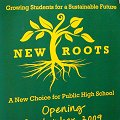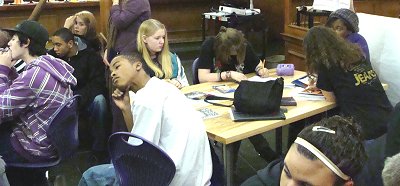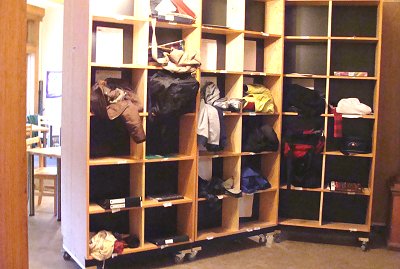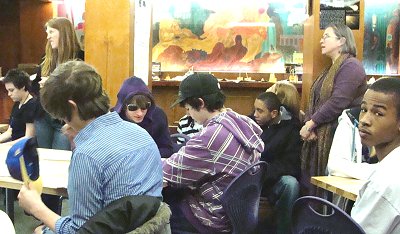- By Dan Veaner
- Around Town
 Print
Print  Part I: Inside New Roots
Part I: Inside New Roots| The New Roots Charter School opened its doors for the first time last September. At that time it was a promise with a lot of unknowns. Now it is a thriving reality. Part 1: Inside New Roots Part 2: Building a School Part 3: New Roots' Impact | ||
"I think that it's going amazingly well, particularly considering that it is the first year," says Principal Tina Nilsen-Hodges. "There are so many different factors at play. We had 100 kids and their prospective families, and teachers who all showed up to make a school together. We have a written plan. We have launched into it and forged all kinds of new relationships, productive working relationships, partnerships with families. We've put systems into place and refined them. We've been working out the kinks."

When you visit New Roots, you get a different vibe than you expect when visiting a traditional public school. As you check in at the front desk students are coming from field trips or internships. One might be playing guitar in the lobby while others are taking a break. Another is sitting on a bench with Dean of Students Rudy Blackman, working out how to get along with another student. One classroom is behind movable walls in the lobby, and it is buzzing with kids engaged in a math class. Some sit at desks, others are grouped around the teacher's desk.
One thing is clear and somewhat surprising because of the intensity of it: these kids really appear to really like being in school, and they obviously like each other. Somehow the buzz of many different activities merges into an excitement about learning together. That atmosphere was part of the plan. In the first two weeks the focus was on building a community above and beyond curriculum, because studying at this school depends so much on students cooperating with one another.
 Walls on wheels: While sharing lobby space with the Kitchen Theatre Company some of New Roots rooms are put up during school hours and taken down after school |
As stated on the school's Web site, the vision is to "empower young people as citizens and entrepreneurs that create just, democratic communities, and thriving green economies that restore the natural world that sustains us. Excelling in both traditional and innovative curriculum areas, our students will learn actively, think critically, and solve problems creatively and collaboratively, developing the knowledge and skills to redesign our communities for social, economic, and ecological sustainability."
That all sounds well and good, but what about the curriculum? How does it measure up to traditional schools and their curriculums? While the approach is radically different in some ways, the goals are the same. Charter schools are public schools, and responsible for helping their students meet or exceed the same 28 learning standards that traditional high schools must. The school offers a Regents diploma. Academically they often outperform traditional schools. In the 2008-09 school year 77% of SUNY charter schools outperformed their districts by 15% or more, and 51% outperformed traditional schools by 20% or more.
In its first year New roots attracted students from 14 regional school districts, with just over 50% of students from the Ithaca City School district. The rest come from districts within and outside of Tompkins County, including Lansing, Trumansburg, Candor, Binghamton, Horseheads, Harpursville, and Odessa-Montour, among others. After Ithaca, Trumansburg students account for the highest number (9 students), with six from Candor, 5 each from Lansing, Newfield, and Dryden, and three or fewer from other districts.
The school was recognized by the Downtown Ithaca Alliance as contributing to downtown economic development by creating over 20 new jobs and attracting nearly $1 million dollars in state and federal grants. 13 of those positions are teachers with the rest administrators and support staff. The school was also recognized with two 'Signs of Sustainability' awards by Sustainable Tompkins for its Farm to School program (which brings students to a local farm where their food is produced, and involves them in its preparation in the lunchroom) and for 'repurposing' the Clinton House. A spaghetti dinner in December to benefit the Farm to School program attracted 200 New Roots supporters.
With many such successes under its belt, the one that will really matter has yet to be evaluated. Obviously it is too early to tell how New Roots will stack up in academic achievement. But charter schools receive more scrutiny than traditional schools typically do. The charter is renewable every five years, and schools that do not perform are in danger of being dissolved. Once a school is established that provides a mighty incentive to teachers and staff whose job security is dependent on earning that renewal. For most New York charter schools that translates into successful students.

Principal Tina Nilsen-Hodges (standing, right) observes
a science class in the Mural Lounge in CLinton House
"The level of accountability that you're held to is really high compared to school districts," Nilsen-Hodges says. "A school district is in no danger of being closed down as a result of consistently low performance, but a charter school has to demonstrate consistently high performance in order to keep the doors open and have its charter renewed every five years."
What New Roots has to offer is not for everyone, however. School officials say that it typically attracts kids who find a better fit for the ways they learn than they did in their home districts. Smaller classes, more personal attention, and mixing activities with 'book learning' are calculated to serve students who may not have 'fit the mold' in their home districts. That personalized learning can pay off in motivation, and therefore, results.
One example is Nilsen-Hodges' son, who she says is a passionate musician. In the first trimester he worked with teachers on translating Spanish songs into English as a way of furthering his Spanish instruction. In science he researched the impact of types of music on behavior.
"I would like to say that our classrooms are a lot more dynamic," says Outreach Coordinator and Science teacher Becca Rodomsky-Bish. "Kids are interacting with each other, socializing with each other, and problem-solving together. In a lot of ways all the teachers try to focus on students as individuals. We're not putting out a cookie-cutter model and expecting that every student is going to fit into it. So a lot of the assignments I give to students are differentiated by what they are interested in."
A Youtube channel has been established to tell people
about New Roots
about New Roots
New Roots has seen about 10% turnover, losing some students who couldn't or didn't want to adapt to differences from their notion of school, and gaining others during the school year. The total student body has fluctuated, and stood at about 97 just before the holiday break. The ninth grade has remained at about 60 students, while the tenth has closer to 40, perhaps because ninth graders didn't have a high school experience to compare it to. Nilsen-Hodges says that the fluctuating number is to be expected, and it offers an opportunity for new students to consider New Roots for the second half of this school year.
"One charter school in Washington State had a 70% turnover in the first year," she notes. "Relatively speaking we've had about 105. We've had some kids leave and others come in. It opens an opportunity now for some kids to come in who have spent the first few months at another school, to see if New Roots would be a better fit for them."
In its first year New Roots has 9th and 10th grades. In 2010-11 it will add 11th grade, and in 2011-12 its first senior/graduating class. That will raise enrollment with a projected target of about 250 students in four grade levels. Nilsen-Hodges is optimistic about filling next year's freshman class. She notes that the school received more 9th grade enrollment forms over the course of the entire enrollment period than there were available spaces.
"If we attracted that many potential 9th graders with the vision and a conversation about what the school might be or could be, I feel very confident that we're in line to bring in a full group of 9th graders for next year," she says. "Now we have real stories about the school to share. We have a Youtube channel with a clip about what students like about New Roots. I think people other than school personnel talking about the school is going to be our biggest area where we have people getting interested in coming here."
Next Week: Building a School
----
v6i1



